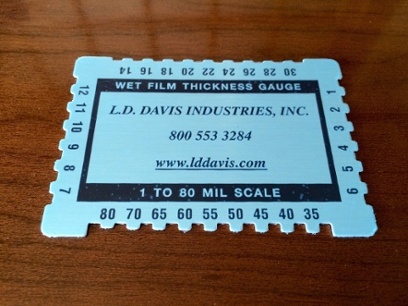One of the best ways to get the most out of your adhesive is to make sure that you apply the appropriate amount to your substrates.
What is the best way to do that? Simple! Measure the amount of adhesive on your substrates using a Mil depth gauge.
What is a Mil Depth Gauge?

A mil depth gauge is a flat, metallic comb that easily allows operators to measure the thickness of a liquid coating before it has been applied to a surface. These gauges have a series of notches or teeth cut into each side like the teeth of a hair comb.
This handy tool is also known as a wet film thickness gauge, step gauge, notched gauge, or combs. Mil gauges are used to measure protein glue and most organic coatings, including resins, paints, varnishes, lacquers, gel coatings, and other types of glue. Powered coatings and hot melt can also be measured before they cure.
How Does a Mil Depth Gauge Work?
On each side of the gauge, the outside notches or teeth are always the same size. This creates what is referred to as a ‘zero reference datum’ and represents the surfaces of the substrate.
All the other notches on the same side of the gauge are incrementally shorter in length than the first and last, showing the different distances from the outside edge. These different lengths are graduated in mils (0.001”) and show the surface of the liquid coating thickness.
How to Properly Measure the Thickness of Adhesive
To use the mil depth gauge:
- Place it directly against the glue roller or coated substrate at 90° until the gauge makes contact.
- Wait for a few moments to let the notches become coated or 'wetted' by the liquid you're measuring.
- Withdraw the gauge vertically.
Read the gauge by examining which notches have become coated or not by liquid. The wet film thickness (WFT) of the liquid coating is between the values of the smallest uncoated (or dry) notch and the largest coated (or wet) notch.
Check out this video from Kelly Pepper at LD Davis to see the Mil Gauge measuring process.
Additional Tips for Measuring
- For rough surfaces, the measurements will most likely be from the surface 'peaks,' and the wet film thickness measurement will represent the minimum overall thickness.
- To measure coating thickness on curved surfaces, use the gauge along the surface's length side or longitudinal axis.
- For fast-drying liquids or coatings like hot glue, take the measurement as quickly as possible to prevent errors.
- Remember to clean the mil depth gauge between each use for best results.
What should be the average thickness of glue?
The answer depends on the kind of adhesive you are using. Always check with your supplier for the correct thickness.
For example, proper glue film thickness for L.D. Davis gelatin glues are about 1-2 mils. Measuring protein glue film thickness accurately is essential, as glue running too thick or too thin can lead to product or equipment issues.
Adding more glue doesn't make the adhesive more secure, and using less glue to stretch a tight budget tends to cause pop-opens and ruined products, adding more time, expense, and labor.
Ready to get measuring? Our team can provide you with a FREE mil depth gauge. If you have any questions about your specific application, let us know.
Editor's note: This blog was originally published in 2017 and has been updated as of 2022.







